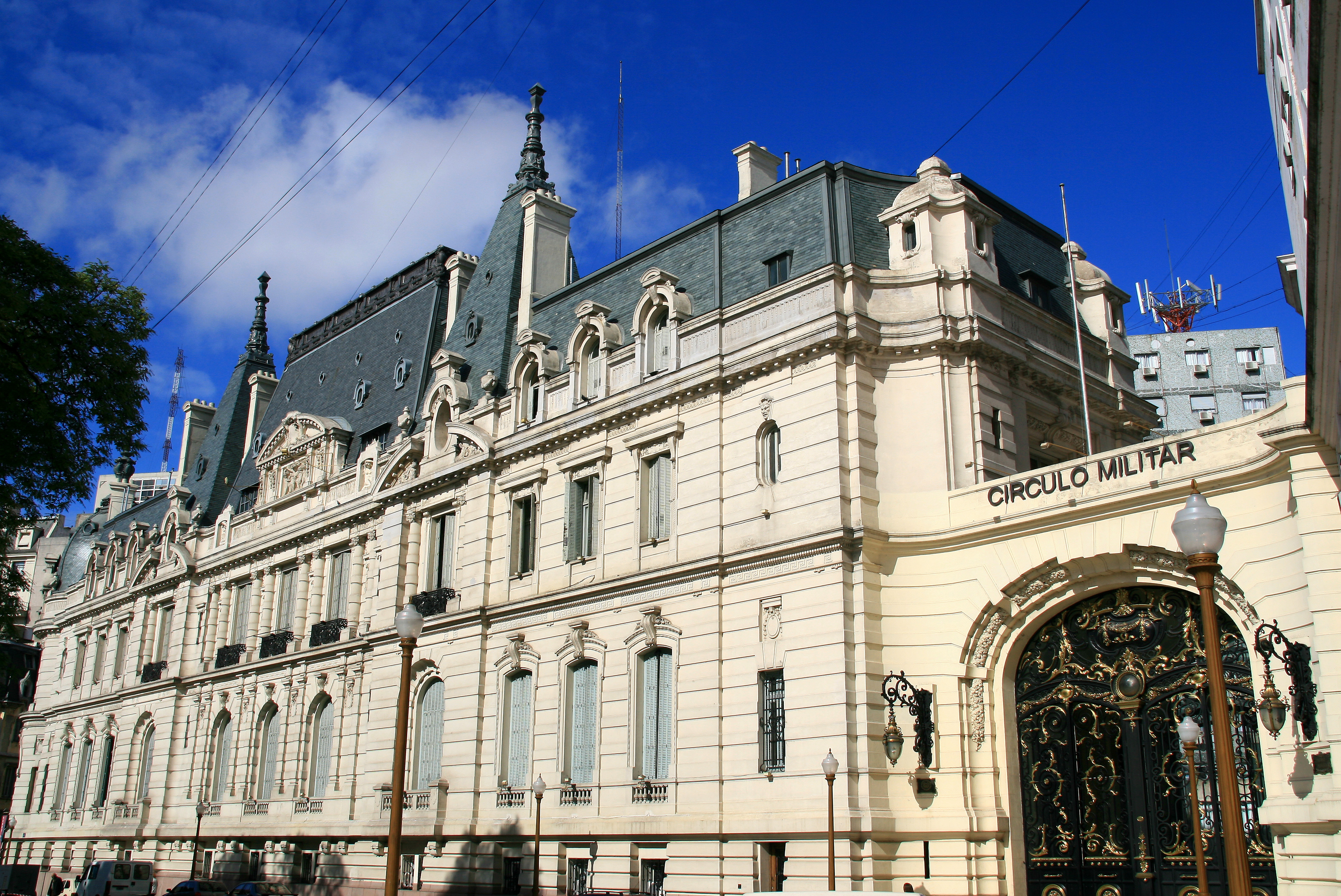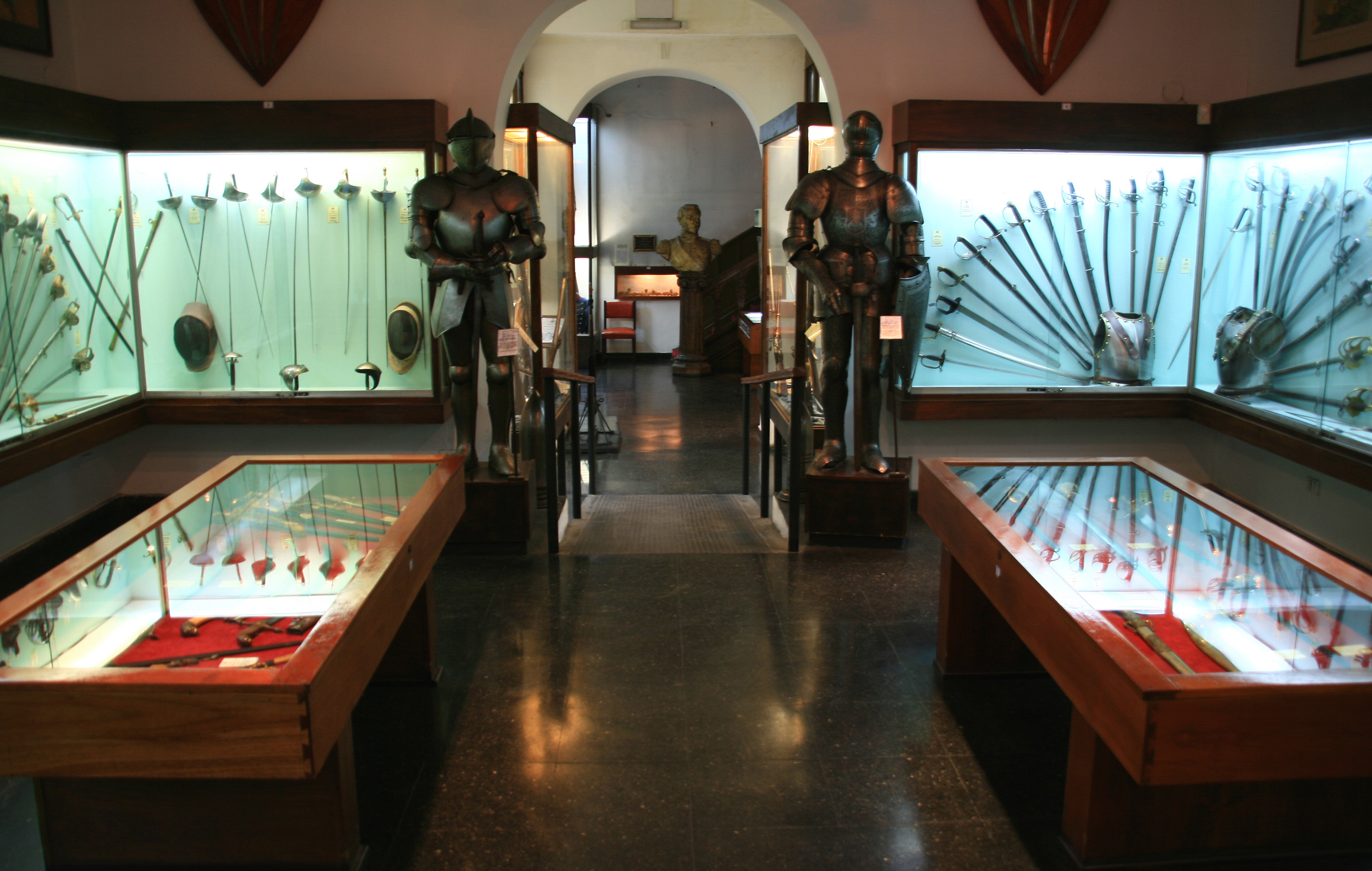Paz Palace on:
[Wikipedia]
[Google]
[Amazon]
 The Paz Palace is a former mansion in
The Paz Palace is a former mansion in
/ref>
 The association established a number of cultural entities. The Officers' Cultural Foundation, which administers the palace as a museum and hosts lectures, expositions and concerts, is maintained in conjunction with the Catholic University of Argentina. The palace also houses the Officers' Library, a small publishing house devoted to the translation of military texts from overseas, as well as its own library, a collection of over 120,000 texts which serves as the primary resource for military history research in Argentina.''El Círculo Militar: 100 años despues.'' Secretaría de Información Pública, 1981.
The association established a number of cultural entities. The Officers' Cultural Foundation, which administers the palace as a museum and hosts lectures, expositions and concerts, is maintained in conjunction with the Catholic University of Argentina. The palace also houses the Officers' Library, a small publishing house devoted to the translation of military texts from overseas, as well as its own library, a collection of over 120,000 texts which serves as the primary resource for military history research in Argentina.''El Círculo Militar: 100 años despues.'' Secretaría de Información Pública, 1981.
 The National Museum of Armaments (Spanish:Museo de Armas de la Nación) is also housed in the Paz Palace. Argentina's most important military museum, it was inaugurated in 1941 and includes 15 rooms where its collection is divided chronologically and by country of origin. Its oldest pieces include a
The National Museum of Armaments (Spanish:Museo de Armas de la Nación) is also housed in the Paz Palace. Argentina's most important military museum, it was inaugurated in 1941 and includes 15 rooms where its collection is divided chronologically and by country of origin. Its oldest pieces include a
Círculo Militar
{{DEFAULTSORT:Paz Palace Military of Argentina Military and war museums in Argentina Palaces in Buenos Aires Houses completed in 1914 Museums in Buenos Aires Museums established in 1941
 The Paz Palace is a former mansion in
The Paz Palace is a former mansion in Buenos Aires
Buenos Aires ( or ; ), officially the Autonomous City of Buenos Aires ( es, link=no, Ciudad Autónoma de Buenos Aires), is the Capital city, capital and primate city of Argentina. The city is located on the western shore of the Río de la Plata ...
, Argentina
Argentina (), officially the Argentine Republic ( es, link=no, República Argentina), is a country in the southern half of South America. Argentina covers an area of , making it the second-largest country in South America after Brazil, t ...
, housing the Military Officers' Association, a social club maintained by the Argentine military
The Armed Forces of the Argentine Republic, in es, Fuerzas Armadas de la República Argentina, are controlled by the Commander-in-Chief (the President) and a civilian Minister of Defense. In addition to the Army, Navy and Air Force, there ...
.
Overview
One of Buenos Aires' most traditionalsocial club
A social club may be a group of people or the place where they meet, generally formed around a common interest, occupation, or activity. Examples include: book discussion clubs, chess clubs, anime clubs, country clubs, charity work, crimin ...
s, the Military Officers' Association was founded in 1881 by Nicolás Levalle, a decorated officer in the Argentine Army
The Argentine Army ( es, Ejército Argentino, EA) is the land force branch of the Armed Forces of the Argentine Republic and the senior military service of Argentina. Under the Argentine Constitution, the president of Argentina is the command ...
who believed such a facility could help mitigate tensions among the officer corps from Argentina's then-fractious provinces. The club relocated to a palace facing San Martín Plaza in 1938. The building was designed by French architect
The following is a chronological list of French architects. Some of their major architectural works are listed after each name.
Middle Ages
Étienne de Bonneuil (late 13th century)
* Uppsala Cathedral, Sweden
Jean de Chelles (13th century ...
Louis Sortais Louis may refer to:
* Louis (coin)
* Louis (given name), origin and several individuals with this name
* Louis (surname)
* Louis (singer), Serbian singer
* HMS ''Louis'', two ships of the Royal Navy
See also
Derived or associated terms
* Lewis ( ...
and built between 1902 and 1914 at the behest of José C. Paz, the proprietor of the city's then-second most-circulated newspaper, ''La Prensa''. Built entirely with material imported for the purpose from France
France (), officially the French Republic ( ), is a country primarily located in Western Europe. It also comprises of overseas regions and territories in the Americas and the Atlantic, Pacific and Indian Oceans. Its metropolitan ar ...
, the palace stands near the eastern end of Santa Fe Avenue, in the Retiro section of Buenos Aires.Frommer's Review: Círculo Militar/ref>

 The association established a number of cultural entities. The Officers' Cultural Foundation, which administers the palace as a museum and hosts lectures, expositions and concerts, is maintained in conjunction with the Catholic University of Argentina. The palace also houses the Officers' Library, a small publishing house devoted to the translation of military texts from overseas, as well as its own library, a collection of over 120,000 texts which serves as the primary resource for military history research in Argentina.''El Círculo Militar: 100 años despues.'' Secretaría de Información Pública, 1981.
The association established a number of cultural entities. The Officers' Cultural Foundation, which administers the palace as a museum and hosts lectures, expositions and concerts, is maintained in conjunction with the Catholic University of Argentina. The palace also houses the Officers' Library, a small publishing house devoted to the translation of military texts from overseas, as well as its own library, a collection of over 120,000 texts which serves as the primary resource for military history research in Argentina.''El Círculo Militar: 100 años despues.'' Secretaría de Información Pública, 1981.
Museum of Arms of the Nation
 The National Museum of Armaments (Spanish:Museo de Armas de la Nación) is also housed in the Paz Palace. Argentina's most important military museum, it was inaugurated in 1941 and includes 15 rooms where its collection is divided chronologically and by country of origin. Its oldest pieces include a
The National Museum of Armaments (Spanish:Museo de Armas de la Nación) is also housed in the Paz Palace. Argentina's most important military museum, it was inaugurated in 1941 and includes 15 rooms where its collection is divided chronologically and by country of origin. Its oldest pieces include a chain mail
Chain mail (properly called mail or maille but usually called chain mail or chainmail) is a type of armour consisting of small metal rings linked together in a pattern to form a mesh. It was in common military use between the 3rd century BC and ...
armor belonging to the Byzantine
The Byzantine Empire, also referred to as the Eastern Roman Empire or Byzantium, was the continuation of the Roman Empire primarily in its eastern provinces during Late Antiquity and the Middle Ages, when its capital city was Constantin ...
Emperor Comnenus
Komnenos ( gr, Κομνηνός; Latinized Comnenus; plural Komnenoi or Comneni (Κομνηνοί, )) was a Byzantine Greek noble family who ruled the Byzantine Empire from 1081 to 1185, and later, as the Grand Komnenoi (Μεγαλοκομνην� ...
(c. 1100), crossbow
A crossbow is a ranged weapon using an elastic launching device consisting of a bow-like assembly called a ''prod'', mounted horizontally on a main frame called a ''tiller'', which is hand-held in a similar fashion to the stock of a long fir ...
s, mace
Mace may refer to:
Spices
* Mace (spice), a spice derived from the aril of nutmeg
* '' Achillea ageratum'', known as English mace, a flowering plant once used as a herb
Weapons
* Mace (bludgeon), a weapon with a heavy head on a solid shaft used ...
s, two-handed sword
The English language terminology used in the classification of swords is imprecise and has varied widely over time. There is no historical dictionary for the universal names, classification or terminology of swords; a sword was simply a double e ...
s, flail
A flail is an agricultural tool used for threshing, the process of separating grains from their husks.
It is usually made from two or more large sticks attached by a short chain; one stick is held and swung, causing the other (the swipple) to ...
s and other weapons dating from the Crusades, and an arquebuse used during the Battle of Aguere
The Battle of Aguere, or Battle of San Cristóbal de La Laguna, was fought between forces of the Crown of Castile, led by the Adelantado (military governor) Alonso Fernández de Lugo, and the natives of Tenerife, called Guanches. The battle took ...
in Spain
, image_flag = Bandera de España.svg
, image_coat = Escudo de España (mazonado).svg
, national_motto = '' Plus ultra'' ( Latin)(English: "Further Beyond")
, national_anthem = (English: "Royal March")
, ...
. The museum also houses a large collection of banners and weapons dating from the Argentine War of Independence
The Argentine War of Independence ( es, Guerra de Independencia de Argentina, links=no) was a secessionist civil war fought from 1810 to 1818 by Argentine patriotic forces under Manuel Belgrano, Juan José Castelli and José de San Martí ...
, including a locally modified Mauser rifle
Mauser, originally Königlich Württembergische Gewehrfabrik ("Royal Württemberg Rifle Factory"), was a German arms manufacturer. Their line of bolt-action rifles and semi-automatic pistols has been produced since the 1870s for the German arm ...
prized at the time for its durability, as well as a modern artillery section tracing the development of the early machine gun
A machine gun is a fully automatic, rifled autoloading firearm designed for sustained direct fire with rifle cartridges. Other automatic firearms such as automatic shotguns and automatic rifles (including assault rifles and battle rifl ...
during the 19th century.
The library is reserved for the association's members and for researchers, though the military museum is open to the public and the Paz Palace itself can be visited through guided tours.
External links and references
Círculo Militar
{{DEFAULTSORT:Paz Palace Military of Argentina Military and war museums in Argentina Palaces in Buenos Aires Houses completed in 1914 Museums in Buenos Aires Museums established in 1941